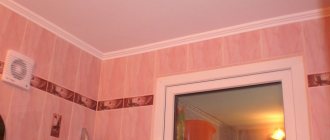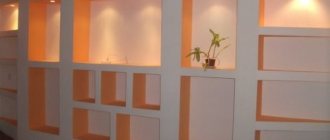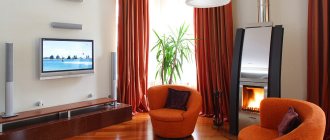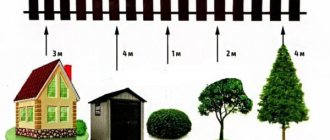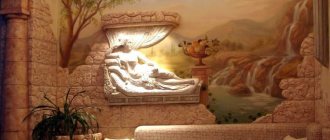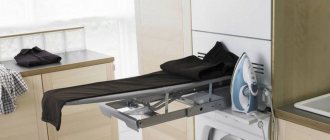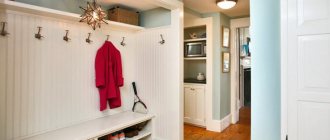There are a great variety of modern finishing materials and design options today. But only some solutions can cause real admiration. One of the ways to decorate the interior wall of an apartment or house is an aquarium in the form of a partition. This interior element does not go out of fashion for a long time. It can be used in rooms for various purposes, be it a living room, a bedroom or even a dining room.
Aquarium and its purpose
An aquarium in a modern home becomes a natural embodiment when a person so needs harmony and tranquility in the bustling passage of time. If we consider this part of the interior from the point of view of the teachings of Feng Shui, it can be noted that it is a carrier of the water element. In this regard, many people install aquariums, guided by the fact that they help attract material wealth.
If the room is small, then using the described technique you can give it lightness and volume. You can complement this part of the room with lighting fixtures, which will focus attention on the built-in aquarium. In addition, quite often designers resort to such modernization of a room in order to hide defects in surfaces or finishes, because all attention will be focused on that part of the space that looks most advantageous.
Varieties and purpose
Similar elements from gypsum plasterboard can be:
- vertical;
- horizontal;
- full-wall floor.
The execution of the structure depends on its purpose. It can take the form of a rack or a decorative element, then it is made open. If a niche is needed for a wardrobe, it can be closed.
Heating systems are often hidden in such recesses. In this case, before making a plasterboard niche in the wall, you need to purchase heat-resistant material.
TV design
Recess for TV.
A modern interior requires maximum free space in the room. And TV “eats up quite a lot of it. Even a flat liquid crystal analog mounted on the wall can make you feel uncomfortable. After all, there is a possibility of hitting it accidentally.
In addition, hanging electrical wires spoil the design of the room. A small niche made of gypsum board (plasterboard sheet) will help hide the TV.
Advantages of this solution:
- the structure is easy to assemble;
- electrical wiring can be disguised behind drywall;
- the monitor will be safe;
- it looks aesthetically pleasing.
If you have an aquarium, you can also put it in a niche you built yourself.
Structures for shelves
When the layout and design of the room already has a wall niche, the best way to use it is to arrange one or several shelves for vases, books, and souvenirs. Walls are not always flat. This is where drywall comes to your aid.
Additionally, a plasterboard wall with niches can be decorated with lighting. Spot-type lamps for it can be installed in any place and order. Electrical wiring can be hidden behind plasterboard sheets. You can place individual or cantilever shelves in the recess (see the article DIY plasterboard niche with lighting: decorating the ceiling with LEDs for more details).
Types and features of aquariums
An aquarium built into a partition can be classified according to several criteria - purpose and shape. According to the first factor, the decor described can be decorative, spawning, quarantine and age-related. But if we are talking about a partition, then you should take into account only decorative aquariums. They can be divided into several more types, among them:
- biotope;
- collectible;
- species.
The former must correspond to the natural habitat, while the latter provides for the presence of only a few species of fish. As for the shape, the partition in the interior usually provides for the presence of rectangular and asymmetrical aquariums, while oval, round and cylindrical ones are usually installed separately.
Features of preparation
With your own hands, an aquarium built into the wall can be installed in a room for any purpose. But this design would look more appropriate in the living room or kitchen. Before starting work, it is necessary to carry out preparatory work. The wall where installation is planned must be free of wiring. It shouldn't be load-bearing. If the wires have been laid for a long time, and it is impossible to find a diagram of its location, then you need to “ring” the wall with a special device. Only after this the marking is carried out. To ensure that the lines are straight, you should use a plumb line or a construction ruler.
To cut holes in the wall, drill several through holes around the perimeter of the rectangle outline. Using the same drill, all holes are connected into a continuous cut. If there is reinforcement in the wall, it is cut off with a grinding machine. Nothing should interfere with the aquarium built into the partition. Therefore, fragments of reinforcement are cut out and removed. After this, you can remove the remaining building materials and dust. Ideally, all this work will be carried out during the renovation.
A fairly important step in installing an aquarium is leveling the slopes. Particular attention should be paid to the horizontal bottom plane, as it will serve as a platform for the structure. The walls are usually leveled with gypsum plaster. After completing this work, all sides are coated with silicone, which will act as waterproofing.
Selecting a location
Each partition is suitable for installing an aquarium, but a load-bearing wall cannot be drilled for this purpose. Among the main requirements, the correct choice of location should be highlighted. This should not be the part of the room that is exposed to the sun most of the day.
If you are considering the idea of an aquarium in the living room, then it is important that the interior of the room does not include a fireplace or other heating device nearby. Typically, such aquariums have an impressive weight, so before starting installation work it is important to make sure that the support is quite strong, because it must bear the load.
Aquarium materials
The main material is, of course, glass. But all other parts (for example, internal filling and frame) can be made from:
- wood;
- glass;
- plastic;
- ceramics;
- stone;
- metal
The latter is used quite rarely, because it undergoes oxidation. In order to eliminate such processes, the elements are coated with special compounds. But even with this, metal elements lose their attractive appearance over time and require replacement. The internal filling is usually made of plastic.
When choosing stones, you should pay attention to:
- granite;
- flint;
- quartz;
- basalt;
Attention! It is important to eliminate lime and also ensure that the elements will not interact with the water in any way, such as staining or polluting it.
When choosing a base material, it is important to consider quality. The glass must be damaged, have a uniform color and not contain harmful impurities released into the liquid. When choosing internal filling, pay attention to ceramic products that act as decorations. If there are coastal areas, you can use wood for decoration. Willow and alder trunks are perfect.
The basis may be acrylic or plexiglass, which is called organic. An alternative solution is silicate glass. By choosing organic glass, you ensure strength and reliability. This material does not interact with water in any way, but has one important drawback - not so high resistance to mechanical stress. The surface can be easily damaged, and over time it even becomes cloudy.
Frameless tanks are made from silicate or organic glass. If the size is impressive, you should choose a frame structure that has metal frames. It is impossible to store such a container without water, as it may become unusable, and the putty will dry out and be destroyed. Seamless plexiglass containers look most impressive. They can protrude beyond the partition and have rounded corners and curved walls.
Shape and dimensions
The aspect ratio of the container will form a certain shape. The ideal configuration for keeping fish is a cube configuration with a side of 50 cm. Such an aquarium holds 125 liters of water. But such a design is rarely used, because the partition will be filled to a limited height.
Usually structures with a small depth and significant height are built into the wall, but they lose in contemplation. It is also important to take into account the peculiarity of the behavior of fish, which by nature are quite shy. If you install a cubic shape, then most of the time you will observe the internal contents, but not the living inhabitants.
In terms of size, rectangular aquariums are quite popular, with the height being higher than the width. You can build a 20 liter aquarium into the wall, which will be easier to care for. Moreover, the partition itself may also have functional niches or drawers.
It is important to consider that when choosing an impressive height that looks more harmonious in the wall, you will have to think about the internal filling, otherwise the water world will look rather sparse in the upper part. Typically, experts do not talk about clear capacity parameters. Therefore, you can choose the dimensions yourself, taking into account the dimensions of the partition.
How to choose a design for premises for different purposes
When choosing a container, you need to take into account the purpose of the room and its size. For example, large aquariums are not suitable for the hallway area, especially if free space is limited. It is better to prefer a miniature version, but choose a non-standard shape. So, aquariums in the form of cylindrical structures look good.
But if there is not much free space, in addition to the container itself, you will also need to think about a place for equipment, namely a cooler and a filter. Some rooms are not at all suitable for such an interior element, since the only place for installation is near the window, and it is extremely undesirable, because algae and fish should not be exposed to sunlight that is harmful to them.
Installation Tips
Of course, there are no specific norms and rules that would regulate the placement of an aquarium in the wall. After all, everything depends solely on what you will be directly dealing with - the parameters of the aquarium and the wall. One option for placing this interesting object is to install it at eye level. The same principle applies to hanging paintings in a gallery. However, it is most suitable if the aquarium is wider than it is tall.
If you have small children, this arrangement of the aquarium with fish will not be very convenient for them. They will be able to see the fish only by standing on the chair. And this once again exposes them to the risk of climbing to heights at a time when you are not around.
It is best to think through the option of installing such an interior element at the stage of global apartment renovation. Because later, when all the work on finishing the room is completed, it will simply be impossible to build an aquarium into the wall without dust, dirt and destruction of the decorative finish of one of the walls. If you are not ready to mount an aquarium into the wall now, but do not discard this option in the future, you may want to think about creating a niche in the wall. While there is no aquarium, it can be used as a small bedside table or a shelf for vases or books. But at any time you can use this niche for its intended purpose.
The aquarium can be installed in the wall in two ways:
- Into a niche, as we wrote about this earlier. This installation method is perfect if one of the rooms is constantly exposed to direct sunlight. Under their influence, glass surfaces will very quickly become overgrown with algae, which, in turn, will require you to clean the glass much more often. In addition, installation in a niche is suitable if you are going to keep fish that constantly dig in the ground. Due to their “violent activity,” the water in the aquarium may always be cloudy. And the back wall of the niche will hide this dregs.
- Installation directly into a special opening in the wall. This way the aquarium will be in two rooms at the same time. And this, you see, is much more attractive. But even before installing it, you will have to work hard. However, the end result is worth it.
Installing an aquarium directly into a special opening in the wall
We do not recommend installing the aquarium itself yourself. It is better to complete all the preparatory work and let professionals install the vessel. After all, thick glass and metal connections weigh a lot. Sometimes it is very difficult even for two people to lift such a structure, not to mention some kind of installation.
It is better to take care to line the bottom of the surface on which the aquarium will be placed with a special polyisol gasket. This point is very important to take into account so that in the future a crack does not occur even from the smallest grain of sand or pebble.
There is also no need to order an aquarium that exactly matches the parameters of a niche or opening in the wall. Be sure to leave a space through which you can feed the fish and clean the glass. So, if the height of the glass is 60 cm, then at least another 40 cm will have to be left for cleaning and feeding. Accordingly, the total height of your opening will be one meter. Be sure to leave space or immediately install all the necessary communications - for lighting, sterilizer, drainage, compressor, and so on.
Original aquarium in the kitchen interior
An aquarium in the interior is a real decoration of your home. If you want to save money on its installation, it is better to do only the preparatory work yourself, and leave the actual installation to specialists. Have you already installed such beauty at home?
Where to place the aquarium
Such a structure must be installed in a place in the home that has sufficient free space. Usually this is the living room or bedroom. Despite all the harmony, an aquarium does not always look advantageous where it does not belong, so you need to carefully think through the style and select the shape.
Kitchen
Here, a small container will look most natural, which will give the room comfort and coziness. If the area of your home is large, you can zone the space in the dining room area, separating it from the kitchen. Here the design will fit well into the entire niche.
Living room
This installation option is classic. The main thing is to choose a design that matches the style of the interior. The partition can be decorative, then it only serves to install the aquarium and does not reach the ceiling. Today, they even sell ready-made walls with aquariums that are installed on site. Often the living room borders on the kitchen area; in this case, you can use a narrow but rather tall aquarium.
Bedroom
Such a piece of furniture is rarely installed in a recreation area, because the operation of its equipment is accompanied by a certain noise. When choosing content, you should avoid flashy bright items that will unnecessarily attract attention. The color of the fish should also be restrained.
Children's
This method of decorating a nursery is rarely used, because even furniture there is usually installed with soft corners, not to mention an object that may pose a danger to the child. But if the child is already growing up, the aquarium will be a great way for him to relax after a hard day at school. To prevent falls, you need to consider a secure base and good fall protection when installing.
Hall
When the size of the corridor is not too limited, you can use a technique such as installing an artificial fish habitat. And the lighting can become a night reference point for household members.
Bathroom
Here the aquarium will look most harmonious, and if it is also built into the wall next to the shower, water treatments will become even more enjoyable. Often artificial ponds in this part of the house are also supplemented with speakers, which will add audio accompaniment to the visual pleasure.
Other suitable room options
The above premises are limited to an ordinary apartment or small house. But if you are the happy owner of a cottage where there are many other rooms, you can also think about where else to install the aquarium. You can consider the option of a wall next to the stairs or a gap between the flights. When there is a recreation room with a swimming pool in the basement, a transparent large container with fish can be an excellent decoration and addition to the space.
Options for an aquarium in the wall between rooms in the interior of the room
There are several options for installing an aquarium:
- Built into the wall.
- Aquarium - partition.
- Built into a decorative partition.
- Built into the floor.
Aquarium built into the wall
When choosing this type, it should immediately be noted that the vessel for the liquid will have a narrow and long shape, and therefore the variety of fish will be scarce. And you will have to choose inhabitants suitable for life in such conditions.
It is best to place the aquarium in the wall so that it is visible from any part of the room
You will have to choose artificial flora for the aquarium due to difficult access to cleaning. The back wall is usually covered with decorative wallpaper. And we must remember, the larger the volume, the harder the cleaning.
Aquarium - partition
Let's look at the advantages and disadvantages of this installation method.
An aquarium partition is often used as a space divider
The advantage is:
- beautiful living room design with an aquarium, which will visually decorate and increase the volume of space;
- a through gap will allow you to observe what is happening in the next room;
- the relaxing effect will now be not only in one room, but in two.
Flaws:
- constant water filtration is required;
- expensive and difficult cleaning;
- the choice of fish will be limited by the condition of inability to hide.
But despite the shortcomings, this option will look very beautiful and will become the main decoration in your apartment.
The volume of some aquariums can reach up to 1000 liters
Built into a decorative partition
It is these aquariums that serve as space dividers. Thanks to the transparent vessel, the room does not lose its volume, and as an advantage, two independent zones appear.
A decorative partition with an aquarium can be placed in any part of the house or apartment
The only thing is that for such decorative partitions it is necessary to leave part of the volume free so that it is convenient to clean and care for the fish. Another plus is using it instead of a night light. Such a good and multifunctional partition will serve as decoration and will delight you for a long time.
The aquarium, viewed from both sides, looks extremely stylish and beautiful.
Built into the floor
A floor aquarium is a very expensive purchase. As a rule, it is not installed in apartment buildings, due to its 30 centimeter thickness.
An aquarium built into the floor is the prerogative of country houses
Basic options for using and designing aquariums
You should not assume that an artificial pond in a partition is a limited way of designing a space. The aquarium can be built not only into a wall, but also into a column and even a clock.
Built into the partition
When this method of designing a partition is chosen, a false wall is usually installed, because in an existing stationary structure it is quite difficult to make an appropriate hole for installing the structure. But if you still want to use such an opening, you can leave a gap on top, which will further lighten the space and make the atmosphere more airy.
Corner designs
Maximum free space does not always look advantageous. Sometimes an area needs to be filled, and this can be done with a corner aquarium. It can be supplemented with functional cabinets, which are most convenient to use in the dining room or living room.
Part of the table
If you have such furniture, then not a single visitor to your home will remain indifferent. Unsightly equipment can be hidden in the legs, which are located on the sides. Such an aquarium will become the center of attention of your home and will distract the eye from the less attractive areas of the room.
Interior partition
You don’t always want to delimit space with monolithic walls, which are difficult to construct and require the installation of doorways. If you want to make the room as modern and colorful as possible, you should install a partition with an aquarium in the middle part. The structure is usually illuminated from above, which makes it appear to be hanging under the surface of the ceiling.
Column aquarium
This piece of furniture is suitable for those who have a small apartment, but want to add aquatic inhabitants to it. The column can be functional and support the ceiling, or mobile.
Aquarium clock
If there is even less space where you could place the container, you should purchase an aquarium in the form of a clock. They will not only allow you to relax and escape from the busy rhythm of work, but will also decorate the interior.
Alternative solutions for aquariums
When there are no plans to install a partition, and there is absolutely no space for it, you can use alternative solutions. For example, an aquarium can be panoramic or designed as a wall decoration.
Overview of species
There are several models of in-wall aquariums, let's look at the most common ones.
The first option is structures built into a niche. Load-bearing structures cannot be used in such an installation, therefore such tanks cannot decorate apartments in panel houses. When vegetation and fish are selected into such a container, its oblong shape is taken into account.
For decoration, artificial flora is usually used, which is clearly visible in the niche. Such designs come complete with a decorative background, and this, of course, does not at all simplify maintenance.
To reduce costs, aquarists prefer containers with a volume of 100-120 liters.
The next option is built-in structures. A small underwater world in the wall between rooms today is considered a very popular option, because it is visible from 3-4 sides, and the interior only benefits from such an element.
But in the case of an aquarium built into a partition, there are certain nuances:
- specialists will connect filtration equipment to the tank, which works all the time;
- in the aquarium you need to change the water and clean it with ultraviolet light, otherwise you cannot avoid the accumulation of organic matter, which is toxic and dangerous;
- To fill such an aquarium, it is necessary to use phenotypes that can withstand stress, because it is not easy to hide in these containers;
- servicing such a tank will take a lot of effort and time.
Another interesting option is to install the tank in a decorative partition, which can be located in any part of the house. It also serves as a decorative space zoner. To make it convenient to maintain the structure, space is left on top, which allows you to easily install lighting equipment, filters and other devices to support life in the aquarium.
And there are also thin aquariums in furniture, in the floor, in a large closet. A good alternative (and much more affordable) to all these options is a large flat artificial aquarium on the wall.
This is nothing more than an imitation, a “trick,” but it can also be stylish, elegant, and impressive.
An artificial hanging aquarium can be compared to an artificial fireplace. Yes, this is only a game in the underwater world, but it also has its advantageous sides .
- Firstly, technology has come very far , and few people can determine at first glance whether it is a real aquarium or an imitation.
- Secondly, there are many people who believe that home aquariums are disrespectful to the animal world and do not dare to buy such “fish houses” for their own amusement. But there are no ethical complaints about the artificial version.
You should not immediately purchase a large and complex aquarium, add rare inhabitants and strange plants there, if you do not have experience in caring for the simplest tank with guppies or cockerels.
It makes sense to study aquariums according to the principle “from simple to complex.”
Aquarium ideas for the living room
To diversify your interior design, you can use interesting techniques, for example, placing an aquarium in such a way that it looks like part of the kitchen unit. You can build it into a partition between two rooms, but do not make it all the way to the ceiling. Such an aquarium can become an extension of the back of the sofa, which zones the space. A technique that involves the appearance of not two opposite, but two adjacent walls looks very interesting. Then you can watch the fish from different angles.
